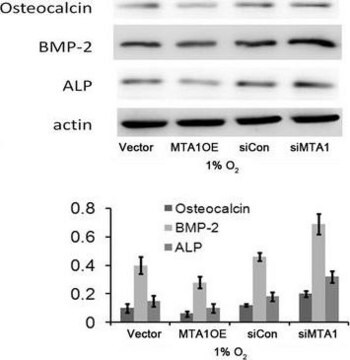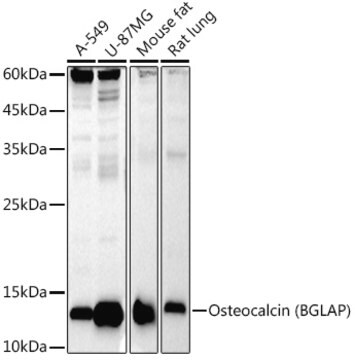일반 설명
We are committed to bringing you greener alternative products, which adhere to one or more of The 12 Principles of Green Chemistry.This antibody is Preservative-free, produced without the harm or sacrifice of animals and exceptionally stable to allow for ambient shipping and storage if needed and thus aligns with "Waste Prevention", "Designing Safer Chemicals" and "Design for Energy Efficiency".
Click here for more information.
ZooMAb® antibodies represent an entirely new generation of recombinant monoclonal antibodies.
Each ZooMAb® antibody is manufactured using our proprietary recombinant expression system, purified to homogeneity, and precisely dispensed to produce robust and highly reproducible lot-to-lot consistency. Only top-performing clones are released for use by researchers. Each antibody is validated for high specificity and affinity across multiple applications, including its most commonly used application. ZooMAb® antibodies are reliably available and ready to ship when you need them.
특이성
Clone 2J18 is a ZooMAb® Rabbit recombinant monoclonal antibody that specifically detects Osteocalcin. It targets an epitope within 21 amino acids from the C-terminal region.
면역원
KLH-conjugated linear peptide corresponding to 21 amino acids from the C-terminal region of human Osteocalcin.
애플리케이션
Quality Control Testing
Evaluated by Western Blotting in Saos-2 cell lysate.
Western Blotting Analysis: A 1,000 dilution of this antibody detected Osteocalin in Saos-2 cell lysate.
Tested applications
Western Blotting Analysis: A 1:1,000 dilution from a representative lot detected recombinant human Osteocalcin.
Affinity Binding Assay: A representative lot of this antibody bound recombinant Osteocalcin with a KD of 1.7 x 10-8 in an affinity binding assay.
ELISA Analysis: Various dilutions of this antibody detected Osteocalcin in ELISA application. proteins.
Note: Actual optimal working dilutions must be determined by end user as specimens, and experimental conditions may vary with the end user
표적 설명
Osteocalcin (UniProt: P02818; also known as Bone Gla protein, BGP, Gamma-carboxyglutamic acid-containing protein) is encoded by the BGLAP gene (Gene ID: 632) in human. Osteocalcin is a member of the osteocalcin/matrix Gla protein family and can constitute 1 to 2% of the total bone protein. It is synthesized by osteoblasts and is a major component of the non-collagenous bone matrix. Osteocalcin is synthesized with a signal peptide (aa 1-23) and a propeptide (aa 24-51) that are subsequently cleaved off to generate the active secreted form of osteocalcin (aa 52-100). Osteocalcin displays a high affinity for calcium and binds strongly to apatite. Sixty to ninety percent of de novo synthesized osteocalcin is incorporated into the bone matrix where it binds to hydroxyapatite during matrix mineralization. The remainder of the osteocalcin is released into the circulation where it can be a sensitive marker of bone formation. Serum osteocalcin is almost exclusively derived from the bone formation with little or no contribution from the resorption process. A major feature of osteocalcin is the presence of 3 vitamin K-dependent g-carboxyglutamic acid (Gla) residues, which are found in the first helical region and interact with the inter-calcium spacing in the HAP lattice. In humans, the percentage of the circulating osteocalcin, which is not g-carboxylated is used as a biomarker of vitamin K status. Osteocalcin expression in osteoblasts is stimulated by insulin and adiponectin and osteocalcin enhances insulin sensitivity and differentiation in muscle. Serum osteocalcin is elevated in diseases characterized by increased bone turnover such as osteoporosis, hyperparathyroidism, and Paget′s disease, and low in conditions associated with low bone turnover such as hypoparathyroidism and growth hormone deficiency. This ZooMAb® recombinant monoclonal antibody, generated by our propriety technology, offers significantly enhanced specificity, affinity, reproducibility, and stability over conventional monoclonals. (Ref.: Kanazawa, I. (2015). World J. Diabetes. 6(18): 1345 1354; Gundberg, CM. et al. (2012). Adv Nutr. 3 (2): 149-157).
물리적 형태
Purified recombinant rabbit monoclonal antibody IgG, lyophilized in PBS, 5% Trehalose, normal appearance a coarse or translucent resin. The PBS/trehalose components in the ZooMAb formulation can have the appearance of a semi-solid (bead like gel) after lyophilization. This is a normal phenomenon. Please follow the recommended reconstitution procedure in the data sheet to dissolve the semi-solid, bead-like, gel-appearing material. The resulting antibody solution is completely stable and functional as proven by full functional testing. Contains no biocide or preservatives, such as azide, or any animal by-products. Larger pack sizes provided as multiples of 25 μL.
재구성
300 μg/mL after reconstitution at 25 μL per vial. Please refer to guidance on suggested starting dilutions and/or titers per application and sample type.
저장 및 안정성
Recommend storage of lyophilized product at 2-8°C; Before reconstitution, micro-centrifuge vials briefly to spin down material to bottom of the vial; Reconstitute each vial by adding 25 μL of filtered lab grade water or PBS; Reconstituted antibodies can be stored at 2-8°C, or -20°C for long term storage. Avoid repeated freeze-thaws.
법적 정보
ZooMAb is a registered trademark of Merck KGaA, Darmstadt, Germany
면책조항
Unless otherwise stated in our catalog or other company documentation accompanying the product(s), our products are intended for research use only and are not to be used for any other purpose, which includes but is not limited to, unauthorized commercial uses, in vitro diagnostic uses, ex vivo or in vivo therapeutic uses or any type of consumption or application to humans or animals.









